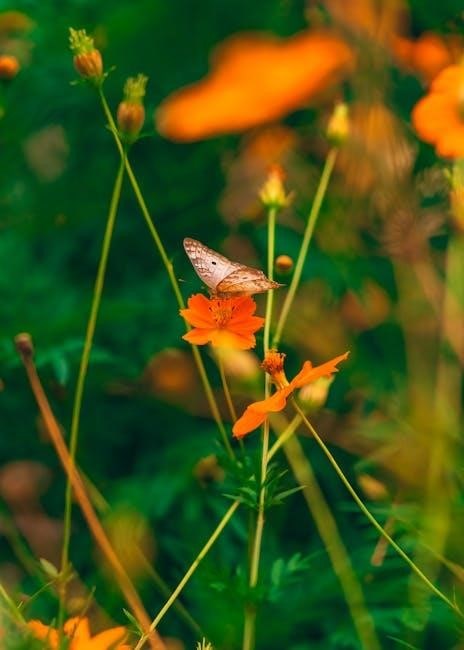
butterfly garden instructions
Welcome to our guide on creating a thriving butterfly garden! This guide provides step-by-step instructions to attract these beautiful pollinators, supporting biodiversity and enhancing your outdoor space with vibrant colors and life.
Importance of Butterfly Gardens
Importance of Butterfly Gardens
Butterfly gardens play a vital role in conservation by providing habitats for these pollinators, supporting biodiversity, and enhancing ecosystem health. They attract butterflies, which pollinate flowers and plants, contributing to the reproduction of various species. By planting native flowers and host plants, these gardens offer food and shelter for caterpillars and adult butterflies. Additionally, they create educational opportunities to raise awareness about butterfly conservation. Butterfly gardens also add beauty and tranquility to outdoor spaces, fostering a deeper connection with nature. Their establishment helps protect declining butterfly populations and promotes environmental sustainability.
Benefits of Creating a Butterfly Garden
Creating a butterfly garden offers numerous benefits, including attracting pollinators, enhancing biodiversity, and providing a vibrant, dynamic outdoor space. These gardens support local ecosystems by offering nectar-rich flowers for adult butterflies and host plants for caterpillars. They also create opportunities for education and community engagement, fostering awareness about conservation. Additionally, butterfly gardens add beauty and tranquility to yards, attracting a variety of wildlife. By planting native species, you contribute to the survival of butterfly populations while enjoying the joy of watching these delicate creatures thrive in their natural habitat.
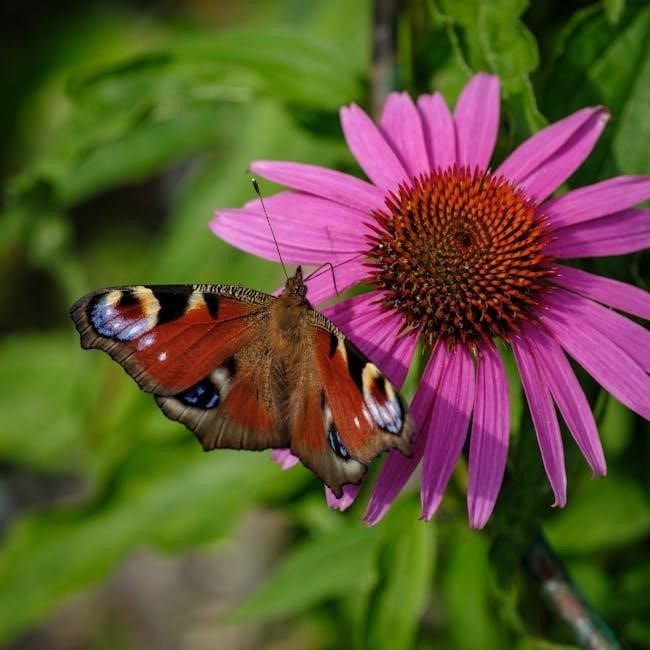
Planning Your Butterfly Garden
Effective planning is key to creating a successful butterfly garden. Choose a sunny location, select nectar and host plants, and design a layout that supports biodiversity and beauty.
Choosing the Right Location
Selecting the right location is crucial for a thriving butterfly garden. Choose a spot that receives at least six hours of direct sunlight daily, as butterflies and their host plants thrive in sunny conditions. Avoid shaded or windy areas, as these can deter butterflies and damage plants. Ensure the location is level and well-drained to prevent waterlogging. Proximity to a water source, like a birdbath or shallow puddle, is also beneficial. Finally, opt for a spot that is easily accessible for maintenance and enjoyment, allowing you to watch these beautiful creatures up close.
Designing the Layout
Designing a butterfly-friendly layout involves creating a welcoming and functional space. Start by grouping nectar-rich flowers and host plants together to provide easy access for butterflies. Incorporate a mix of perennials and annuals to ensure continuous blooms throughout the growing season. Add decorative elements like rocks or a shallow water feature to serve as landing sites. Consider the mature size of plants when spacing them to avoid overcrowding. A well-organized design not only attracts butterflies but also enhances the visual appeal of your garden, making it a delightful spot for both wildlife and visitors to enjoy year-round.
Selecting the Right Plants
Choosing the right plants is essential for attracting butterflies. Opt for native species, perennials, and annuals that provide nectar for adults and host plants for caterpillars, ensuring blooms year-round.
Nectar Plants for Adult Butterflies
Nectar plants are vital for adult butterflies, providing the energy they need to fly and reproduce. Choose colorful, nectar-rich flowers like Lantana, Butterfly Bush, and Zinnias, which attract a variety of species. Bright colors such as yellow, orange, and purple are particularly appealing. Plant a mix of annuals and perennials to ensure continuous blooms throughout the growing season. Native plants are especially beneficial, as they naturally attract local butterfly species. Incorporate flowers with different shapes and sizes to cater to various butterfly preferences. Place these plants in sunny areas, as butterflies are sun-loving creatures. This will create a welcoming habitat for these beautiful pollinators.
Host Plants for Caterpillars
Host plants are essential for caterpillars, as they provide the necessary food for growth and development. Different butterfly species rely on specific plants for their larvae. For example, monarch caterpillars depend on milkweed, while black swallowtails prefer plants like dill or fennel. Incorporate native plants, as they naturally support local butterfly species. Planting a variety of host plants ensures that caterpillars have ample food sources. These plants should be placed in areas protected from strong winds and pests. By providing host plants, you create a nurturing environment for caterpillars to thrive and transform into beautiful butterflies.
Native Plants and Their Importance
Native plants are crucial for a successful butterfly garden, as they naturally attract local butterfly species. These plants have evolved alongside the butterflies, providing the right nutrients and shelter. They are also easier to maintain, as they are adapted to the local climate and soil conditions. Incorporating native plants ensures a sustainable and biodiversity-rich environment. Additionally, they often require less water and care, making them a practical choice. By planting native species, you support the local ecosystem and create a welcoming habitat for butterflies to flourish. This approach also helps preserve the natural balance of your region’s flora and fauna.
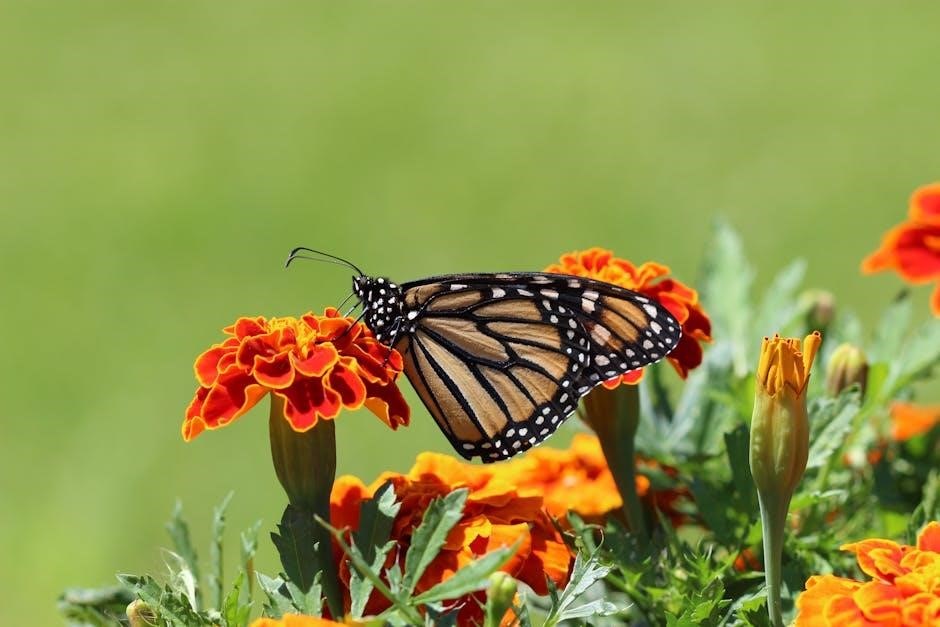
Providing Water Sources
Providing water sources is essential for butterflies, as they need it for drinking and obtaining minerals. Create shallow puddles or install a birdbath to meet their needs.
Creating Shallow Water Puddles
Butterflies often gather at shallow water sources to drink and extract essential minerals. To create a butterfly-friendly water puddle, use a shallow container filled with fresh water and place it in a sunny spot. Add rocks or twigs for perches, allowing butterflies to land and sip comfortably. Change the water regularly to prevent mosquito breeding and keep the area clean. This simple feature will attract various butterfly species and support their survival, making it a vital component of your butterfly garden.
Installing a Birdbath for Butterflies
Installing a birdbath tailored for butterflies can be a delightful addition to your garden. Place the bath in a sunny, accessible spot, ensuring the water remains shallow with rocks or twigs for perches. Regularly refresh the water to maintain cleanliness and prevent mosquito larvae. This feature not only attracts butterflies but also provides them with essential hydration and minerals, enhancing their overall well-being and making your garden a welcoming haven for these beautiful creatures.
Maintenance Tips
Regular mulching, soil care, and seasonal pruning ensure your butterfly garden thrives. Use appropriate fertilizers and maintain plant health to support butterflies and pollinators effectively.
Caring for Butterfly-Friendly Plants
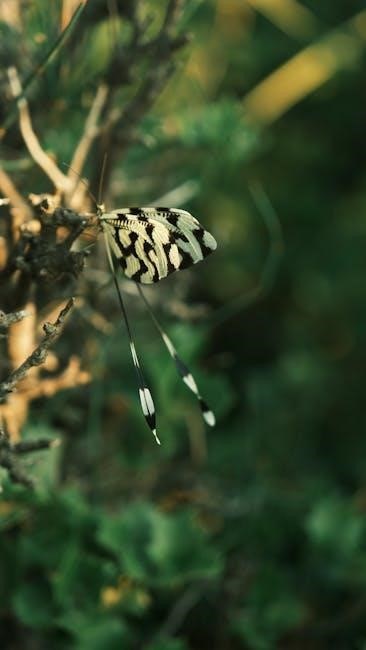
Butterfly-friendly plants require careful maintenance to thrive. Ensure they receive full sunlight and adequate water, but avoid overwatering to prevent root rot. Fertilize lightly during the growing season to promote healthy blooms. Deadheading spent flowers encourages continuous blooming, while pruning back overgrown plants maintains their shape and vigor. Mulch around plants to retain moisture and suppress weeds. Regularly inspect for pests and diseases, treating organically when necessary. Avoid invasive species that may harm local ecosystems. Proper care ensures your plants remain vibrant, providing nectar for adults and host leaves for caterpillars, creating a welcoming habitat for butterflies year-round.
Mulching and Soil Care
Mulching is essential for retaining moisture and suppressing weeds in your butterfly garden. Use organic mulch like wood chips or bark, applying a 2-3 inch layer around plants. Avoid over-mulching, as it can suffocate roots. Soil health is crucial, so test pH levels and amend if necessary. Incorporate compost to enrich the soil with nutrients, promoting robust plant growth. Keep the soil consistently moist but well-drained to prevent root rot. Avoid chemical fertilizers that harm pollinators. Proper mulching and soil care create a nurturing environment for both nectar and host plants, ensuring a thriving butterfly habitat.
Seasonal Care and Pruning
Seasonal care is vital for maintaining a healthy butterfly garden. Prune plants in early spring to promote new growth and remove dead or damaged stems. For perennials, cut back foliage after the first frost, while leaving some seed heads for winter interest; In fall, clean up debris to prevent disease and pests. Lightly fertilize in spring and summer to support plant growth. Avoid over-pruning, as butterflies rely on certain stems for nesting. Regular pruning ensures a balanced ecosystem, keeping your garden attractive and functional for both butterflies and plants year-round.
Additional Elements for Your Butterfly Garden
Enhance your butterfly garden with a feeder for nectar, decorative rocks for perches, and shallow water puddles. These elements create a welcoming habitat and add visual interest.
Installing a Butterfly Feeder
Installing a butterfly feeder is a simple way to provide a steady nectar source for these pollinators. Choose a feeder designed for butterflies, often resembling shallow dishes or trays with feeding ports; Place the feeder in a sunny spot near your butterfly garden, ensuring easy access for the butterflies. Fill the feeder with a sugar-water solution (4 parts water to 1 part sugar) or store-bought nectar. Avoid using artificial sweeteners or red dye. Regularly clean and refill the feeder to prevent mold growth, ensuring a constant food supply for visiting butterflies throughout the season.
Adding Decorative Rocks and Perches
Decorative rocks and perches add both aesthetic value and functionality to your butterfly garden. Place flat rocks in sunny spots for butterflies to bask on, as they often warm up their wings on such surfaces. Incorporate perches like thin branches or twigs near nectar sources, allowing butterflies to rest while feeding. These elements also provide landing sites for pollinators, enhancing their overall experience. Ensure rocks and perches are strategically placed to complement the garden’s design without overcrowding plants, creating a harmonious and inviting habitat for butterflies and other visitors.
Creating Windbreaks
Windbreaks are essential for protecting butterflies from harsh winds that can hinder their flight and feeding abilities. Use natural elements like shrubs, native plants, or trees to create a barrier around your garden. Alternatively, install a fence or screen to block strong gusts while allowing gentle airflow. Strategic placement of windbreaks ensures butterflies can navigate and feed comfortably. This feature enhances the overall functionality of your garden, creating a sheltered oasis that supports these delicate creatures and promotes a thriving ecosystem tailored to their needs.
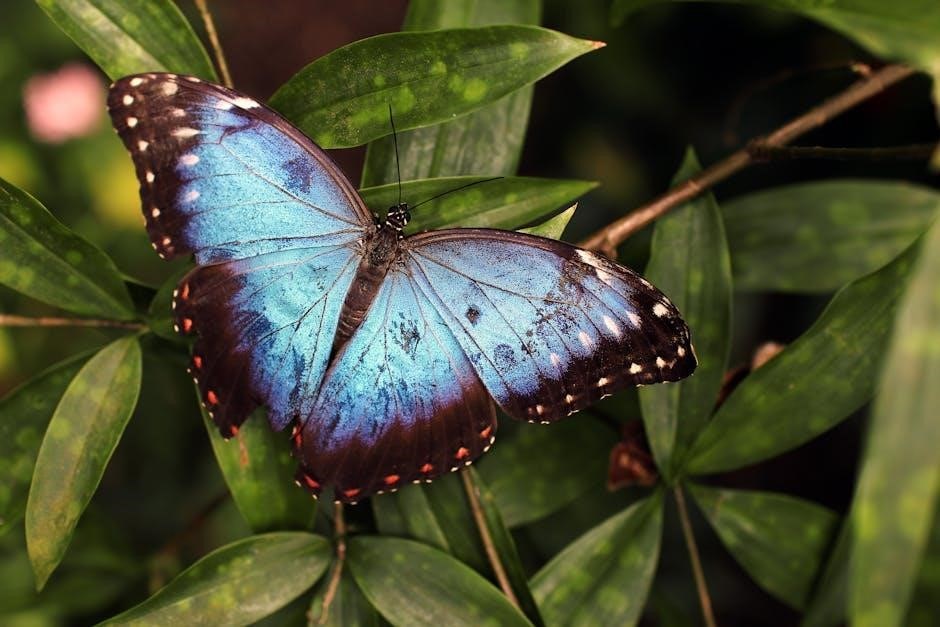
Benefits of a Butterfly Garden
A butterfly garden supports pollinators, enhances biodiversity, and offers personal enjoyment. It creates a serene environment, fosters education, and connects people with nature’s beauty and life cycles.
Supporting Pollinators
A butterfly garden plays a vital role in supporting pollinators like butterflies, bees, and hummingbirds. By planting nectar-rich flowers, you provide energy for adult butterflies, while host plants sustain caterpillars. This mutual relationship promotes pollination, essential for flower fertilization and seed production. Native plants are particularly effective, as they naturally attract local pollinators. A well-designed garden not only aids butterflies but also benefits other pollinators, enhancing biodiversity and ecosystem health. This creates a sustainable environment where wildlife thrives, supporting the balance of nature and fostering a healthier planet for future generations.
Enhancing Biodiversity
A butterfly garden significantly enhances biodiversity by attracting a variety of pollinators and beneficial insects. These gardens provide habitats for butterflies, bees, and other wildlife, fostering a balanced ecosystem. Native plants play a crucial role in supporting local species, ensuring the garden aligns with the surrounding environment. By creating a welcoming space for diverse wildlife, you contribute to the preservation of natural habitats and strengthen local food chains. This biodiversity boost not only benefits butterflies but also enriches the overall health of your ecosystem, making it more resilient and vibrant.
Personal Enjoyment and Relaxation
Creating a butterfly garden offers immense personal enjoyment and relaxation. Watching these delicate creatures flit from flower to flower can be a source of joy and tranquility. The vibrant colors and graceful movements of butterflies create a soothing atmosphere, perfect for unwinding. Additionally, the process of nurturing a butterfly-friendly environment fosters a sense of accomplishment and connection to nature. Whether you’re observing their behavior or photographing their beauty, a butterfly garden provides endless opportunities for recreation and mindfulness, transforming your outdoor space into a serene retreat.
Case Study: A Successful Butterfly Garden Plan
A community garden transformed a sunny spot into a vibrant butterfly haven using native plants, shallow water sources, and colorful blooms, attracting diverse species and fostering biodiversity.
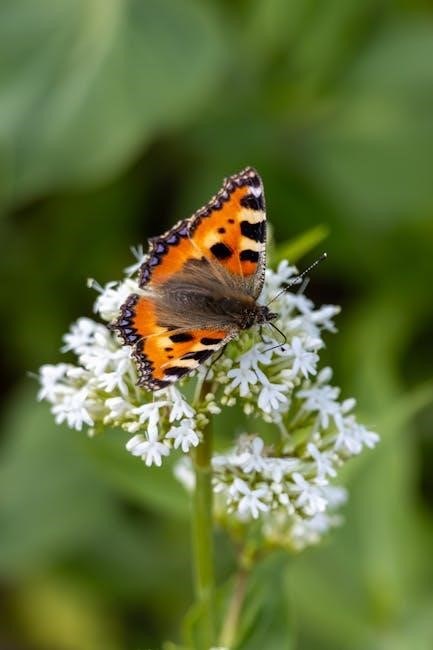
Example Layout and Plant Selection
A successful butterfly garden layout includes a mix of nectar-rich flowers, host plants for caterpillars, and water sources. Plant native species like milkweed and butterfly bush for monarchs, and incorporate vibrant blooms such as lantana and zinnias to attract a variety of species. Arrange plants in clusters to provide warmth and shelter. Add shallow water puddles with rocks for drinking and mineral gathering. Consider a sunny spot, as butterflies thrive in warmth. Avoid invasive plants and include host plants like parsley for caterpillars. This balanced design supports both adult butterflies and their larvae, fostering a thriving ecosystem.
Success Stories from Butterfly Gardeners
Butterfly gardeners worldwide share inspiring stories of their gardens’ positive impact. Many report increased biodiversity, with native plants attracting local butterfly species. Community gardens have become hubs for education, fostering a love for nature among residents. For instance, the Live Monarch Educational Foundation distributes milkweed seeds, helping gardeners support monarch butterflies. These success stories highlight how small efforts can lead to significant environmental benefits, encouraging others to create their own butterfly-friendly spaces and contribute to pollinator conservation efforts.
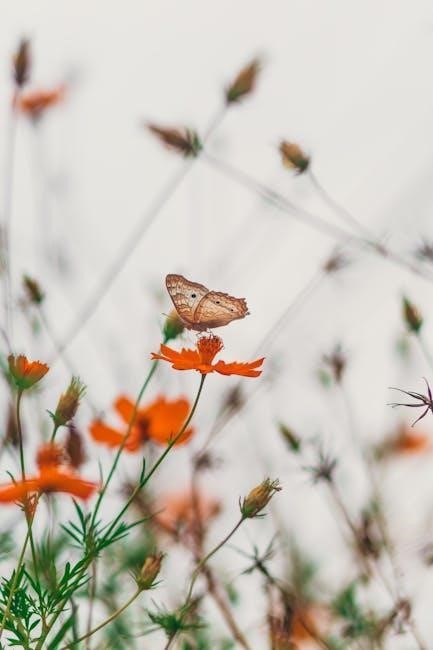
Tools and Materials Needed
Essential tools include a trowel, shovel, gloves, and watering can. Materials like mulch, native plants, and fertilizers are crucial for creating a butterfly-friendly habitat.
Essential Tools for Garden Setup
Setting up a butterfly garden requires the right tools to ensure success. A trowel or small shovel is necessary for planting flowers and host plants. Gloves protect your hands while gardening. A watering can or hose with a gentle spray nozzle helps maintain soil moisture without washing away caterpillars. Pruning shears are useful for trimming plants and encouraging healthy growth. A wheelbarrow or garden cart can assist in transporting soil, mulch, and plants. Additionally, a garden fork is handy for loosening soil and preparing beds. These tools will help you create a welcoming habitat for butterflies and caterpillars.
Recommended Materials
Creating a butterfly garden requires selecting the right materials to attract and support these pollinators. Use native plants, as they are naturally suited to local butterfly species. Incorporate nectar-rich flowers like milkweed, zinnias, and lantana to provide food for adults. Host plants, such as parsley or dill, are essential for caterpillars. Organic mulch helps retain soil moisture and suppress weeds. A shallow water source, like a birdbath with stones, is ideal for butterflies to drink. Avoid invasive plants, as they can harm the ecosystem. Fertilizers should be used sparingly to maintain plant health without harming wildlife.
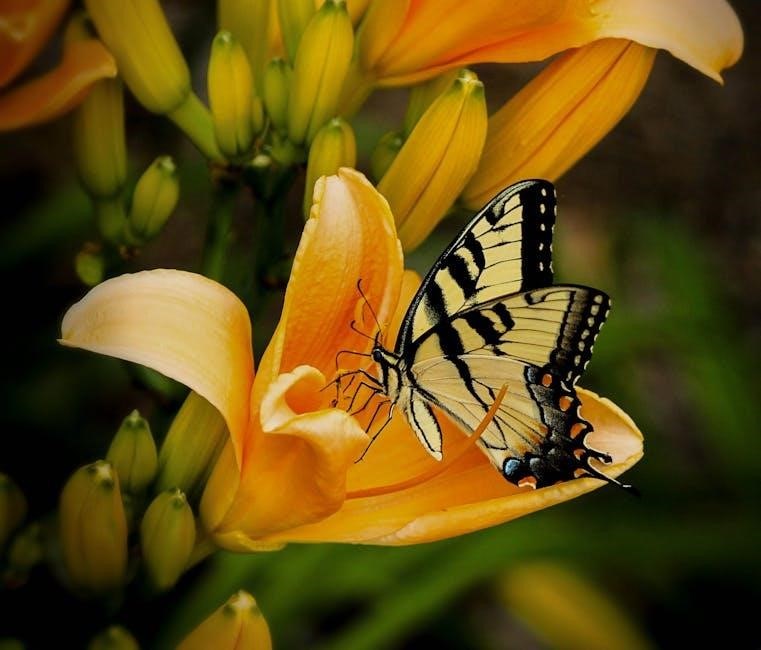
Monitoring and Enjoying Your Butterfly Garden
Observe butterfly behavior, track species visitors, and enjoy the vibrant colors they bring. Photograph these beautiful creatures to capture memories of your thriving pollinator-friendly habitat and its seasonal changes.
Observing Butterfly Behavior
Observing butterfly behavior in your garden offers insights into their life cycles and preferences. Watch as they feed on nectar, mate, and lay eggs on host plants. Notice how they bask in sunlight to regulate their body temperature and fly in specific patterns. Tracking their activity helps you understand their needs and ensures your garden remains a welcoming habitat. Keep a journal to record species, behaviors, and seasonal changes, enhancing your appreciation for these fascinating creatures and their role in your ecosystem.
Photographing Butterflies
Photographing butterflies in your garden can be a rewarding hobby, capturing their beauty and unique behaviors. Use a camera with good zoom and macro capabilities to get detailed shots. Be patient, as butterflies can be skittish, and shoot in natural light for vibrant colors. Aim for early mornings or late afternoons when they are most active. Experiment with angles, focusing on wings and flower interactions. Keep the background clean to highlight your subject. This hobby not only preserves memories but also deepens your connection to these graceful creatures and their habitat.
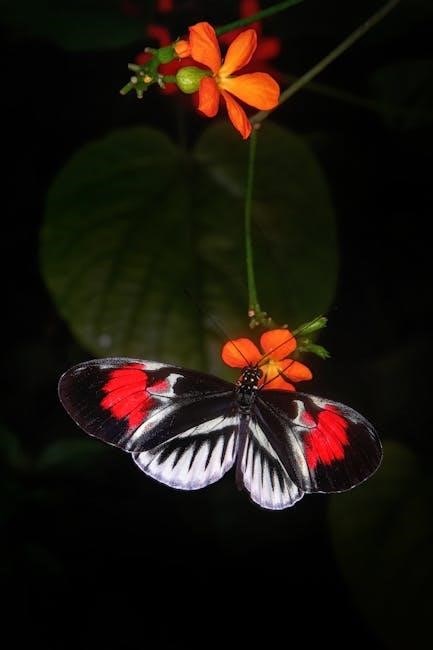
Troubleshooting Common Issues
Common issues in butterfly gardens include pests, plant diseases, and lack of visitors. Use natural predators and organic treatments to address pests. Ensure plants are healthy and well-maintained to attract butterflies consistently.
Dealing with Pests
Pests like aphids, spider mites, and caterpillars can harm your butterfly garden. Introduce natural predators such as ladybugs or parasitic wasps to control infestations. Avoid chemical pesticides, as they can harm butterflies. Instead, use neem oil or insecticidal soap for targeted treatment. Hand-picking pests can also be effective for small-scale issues. Maintain plant health through proper watering and nutrients to help plants resist pests. Isolate infected plants to prevent the spread of disease. Regularly inspect your garden to catch problems early and take action before infestations escalate. This balanced approach ensures a thriving ecosystem for butterflies and plants alike.
Addressing Plant Diseases
Plant diseases can threaten the health of your butterfly garden. Regularly inspect plants for signs of disease, such as yellowing leaves, black spots, or powdery mildew. Remove and dispose of infected leaves or stems to prevent spread. Treat fungal infections with organic fungicides like neem oil or copper-based products. Ensure proper spacing between plants for air circulation and avoid overwatering, which can lead to root rot. Use disease-resistant plant varieties when possible. Maintain healthy soil with compost and balanced fertilizers to strengthen plant immunity. Addressing issues early helps preserve the overall health of your butterfly-friendly garden ecosystem.
Involving the Community
Engage neighbors and local groups in your butterfly garden project. Organize workshops, planting sessions, and educational programs to foster shared responsibility and community pride in the effort.
Creating a Community Butterfly Garden
Building a community butterfly garden fosters collaboration and shared joy. Gather local volunteers to design and maintain the space, ensuring it reflects a collective vision for biodiversity and beauty. Partner with schools, gardening clubs, or conservation groups to engage a diverse audience. Organize workshops on plant selection, habitat creation, and butterfly life cycles to educate participants. Include interactive elements like observation areas and educational signs to enhance community involvement. This shared effort not only supports pollinators but also strengthens neighborhood bonds and promotes environmental stewardship. Celebrate milestones to encourage ongoing participation and pride in the project.
Educational Programs and Workshops
Educational programs and workshops are essential for spreading knowledge about butterfly gardens. These sessions teach participants about plant selection, butterfly life cycles, and conservation efforts. Many programs offer hands-on activities, such as planting milkweed or creating habitats. Workshops often include expert speakers and resource materials like guides and seed kits. They also highlight the importance of pollinators and how community involvement can protect them. By educating people of all ages, these programs inspire action and foster a deeper appreciation for biodiversity and environmental stewardship, making them a vital part of any successful butterfly garden initiative.
Creating a butterfly garden is a rewarding journey that supports pollinators, enhances biodiversity, and brings joy to your outdoor space. Thank you for joining us on this guide to building a thriving butterfly garden—happy gardening!
Final Tips for a Thriving Butterfly Garden
- Choose native, nectar-rich plants to attract local butterfly species.
- Provide shallow water sources or birdbaths for drinking and mineral intake.
- Avoid pesticides to protect butterflies and other pollinators.
- Create windbreaks using shrubs or plants to shield butterflies from strong winds.
- Place your garden in a sunny spot, as butterflies thrive in warm conditions.
- Use organic mulch and balanced fertilizers to maintain healthy soil.
- Regularly prune and care for plants to ensure continuous blooms.
- Incorporate host plants for caterpillars to support their life cycle.
- Add decorative rocks and perches for butterflies to rest and sunbathe.